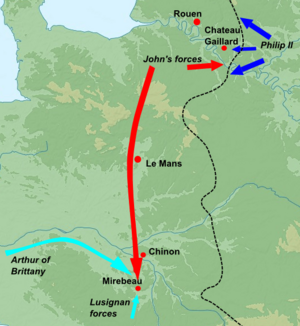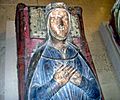Battle of Mirebeau facts for kids
Quick facts for kids Battle of Mirebeau |
|||||||
|---|---|---|---|---|---|---|---|
| Part of the French Invasion of Normandy | |||||||
 Movement of Arthur of Brittany and Hugh de Lusignan's alliances, Philip II's French army, and John of England's forces, culminating in the Battle of Mirebeau. |
|||||||
|
|||||||
| Belligerents | |||||||
| Kingdom of England | House of Lusignan Duchy of Brittany |
||||||
| Commanders and leaders | |||||||
| King John William des Roches |
Hugh X (POW) Duke Arthur (POW) |
||||||
| Strength | |||||||
| Mercenary Army | Rebels | ||||||
| Casualties and losses | |||||||
| unknown | heavy | ||||||
The Battle of Mirebeau was an important fight in 1202. It happened between King John of England and an alliance of nobles from the Lusignan family and Brittany. King John's army surprised and defeated the Lusignan forces.
Contents
Why the Battle Happened
Who Should Be King?
After King Richard I (Richard the Lionheart) died in 1199, there were two main people who wanted to be king. One was John, Richard's younger brother. The other was Arthur I of Brittany, Richard's nephew.
Different laws in different places supported each of them. In Normandy, John was favored because he was the last living son of the previous king, Henry II. But in other areas like Anjou, Arthur was favored because he was the son of Henry II's older son.
Most English and Norman nobles supported John. His mother, Eleanor of Aquitaine, also backed him. John was crowned king in England. Arthur had support from nobles in Brittany, Maine, and Anjou. He also had help from Philip II of France, who wanted to weaken John's power in France.
How Wars Were Fought Back Then
Wars in this time often involved attacking castles. Castles were strong and expensive to build and defend. It was hard for an army to move far without capturing these strongholds first. This made battles slow.
Armies were made of two types of soldiers. Some were feudal levies, meaning nobles brought their own knights for a short time. Others were mercenaries, paid soldiers who fought all year. Mercenaries were more expensive but gave kings more options.
A Short Peace
After becoming king, John moved his army to France. He defended the borders of Normandy. Both sides talked about peace for a while. John's position got stronger when powerful counts like Baldwin IX of Flanders and Renaud of Boulogne agreed to be his allies against France.
A powerful nobleman named William des Roches also switched his support from Arthur to John. This made John's side much stronger. In January 1200, John and Philip agreed to a peace treaty called the Treaty of Le Goulet. Philip recognized John as the rightful ruler of Richard's lands in France. John, in turn, accepted Philip as his feudal lord for his French lands. Some people called John "John Softsword" because they thought he gave up too much in this treaty.
The Marriage That Started a War
This peace lasted only two years. War started again after John decided to marry Isabella of Angoulême in August 1200. John had to end his first marriage to Isabel, Countess of Gloucester to marry Isabella.
It's not fully clear why John married Isabella. Some say he fell in love with her. Others believe it was for strategic reasons. Isabella's lands in Angoumois were very important. They provided a key route between two of John's territories, Poitou and Gascony. This marriage would strengthen his control over Aquitaine.
However, Isabella was already engaged to Hugh X of Lusignan. He was an important noble from a powerful family in Poitou. John treated Hugh "with contempt" instead of offering him something for the broken engagement. This made the Lusignan family angry. They rebelled against John, but he quickly defeated them.
The Appeal to King Philip
Even though John was the ruler of Poitou, the Lusignans could ask King Philip II of France for help. Philip was John's feudal lord for his lands in France. Hugh did this in 1201. Philip then ordered John to come to his court in Paris in 1202.
John refused to go. He said that as Duke of Normandy, he didn't have to attend the French court. Philip argued that he was summoning John as Count of Poitou, which had no such special rule. When John still refused, Philip declared that John had broken his duties as a vassal. Philip then gave all of John's French lands (except Normandy, which Philip took for himself) to Arthur. This started a new war against John.
The Battle of Mirebeau
At first, King John tried to defend his castles, just like he did in 1199. But the war became more confusing for him, and King Philip started to gain ground. In July 1202, John learned that Arthur's forces were attacking his mother, Eleanor, at Mirebeau Castle.
John quickly moved his mercenary army south to protect her. He was joined by William des Roches, a key official in Anjou. John's forces surprised Arthur's army. They captured Arthur and all the other rebel leaders at the Battle of Mirebeau. It is also likely that Eleanor, Fair Maid of Brittany, Arthur's older sister, was captured too. With his southern forces weakened, King Philip had to pull back and move south to deal with John's army.
What Happened Next
Even though John won at Mirebeau, King Philip II of France still fought against him. Soon after the battle, Arthur disappeared. It is widely believed that Arthur died soon after. With Eleanor, Arthur's sister, kept safely in prison in England, John had secured his claim to the throne.
However, John's actions against Arthur made many local nobles turn against him. For the next two years, John treated the nobles of Anjou and Poitou so badly that many of them switched sides to support Philip II. Philip slowly captured more castles in Normandy. This led to the Siege of Château Gaillard, a very important castle, which ended in 1204. John tried to help the castle, but his efforts failed. The castle fell, and John lost almost all his lands in France.
Eleanor's imprisonment meant she could not become the ruler of Brittany. The next ruler of Brittany was Alix, Arthur's half-sister.
Images for kids
-
The tomb of Isabella of Angoulême, King John's second wife.


